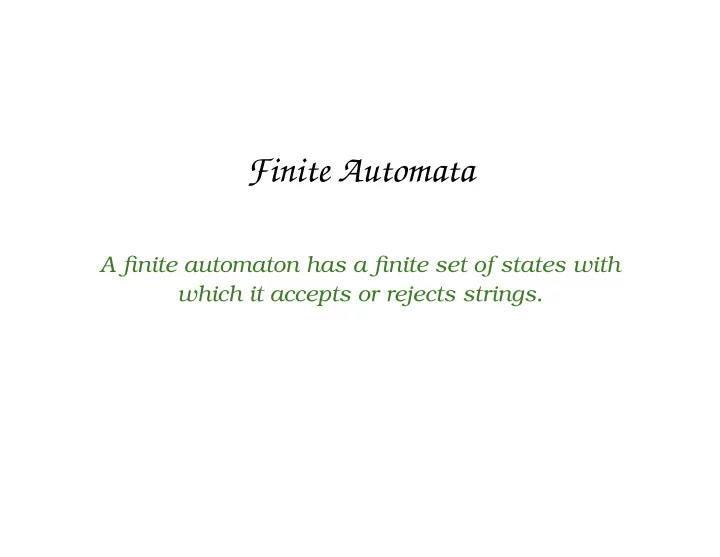

Finite Automata A finite automaton has a finite set of states with which it accepts or rejects strings.
A Finite Automaton An FA has three components: 1. input tape contains single string; 2. head reads input string one symbol at a time; and 3. Memory is in one of a finite number of states. Goddard 1: 2
Operating an FA Operating an FA. 1) Set the machine to start state. 2) If End-of-String then halt. 3) Read a symbol. 4) Update state according to current state and symbol read. 5) Goto Step 2. Goddard 1: 3
An FA Accepts Strings “Program” prescribes how symbols read affect current state. Final state is state FA is in when finished read- ing the input string. There are accept states (double circle) and re- ject states. An FA accepts input string if final state is ac- cept state; otherwise it rejects. Goddard 1: 4
An Example FA 1 0 0 0 A B C 1 1 Final state for 101001 is C , final state for 11101 is A . Goddard 1: 5
Example FA 1 A B 0 1 0 Accepts all strings of 0 ’s and 1 ’s with odd num- ber of 1 ’s. Goddard 1: 6
Terminology alphabet is a set of symbols (often denoted Σ ) language is a set of strings ( unary language means | Σ | = 1 ) language of FA is the set of strings it accepts length of a string is the number of symbols empty string is denoted ε . Goddard 1: 7
Building FAs: Do the Obvious Starts with 00 : Goddard 1: 8
Building FAs: Do the Obvious Starts with 00 : 0 0 0 , 1 A B C 1 1 D 0 , 1 Goddard 1: 9
Building FAs: Recent Memory Ends with 00 : Goddard 1: 10
Building FAs: Recent Memory Ends with 00 : 0 0 0 A B C 1 1 1 Goddard 1: 11
Building FAs: Traps A trap is state that, once entered, one can never leave. Used to reject partly read strings that will never be accepted, or to accept partly read strings that will definitely be accepted. Goddard 1: 12
Example with a Trap Alternating 0 ’s and 1 ’s: Goddard 1: 13
Example with a Trap Alternating 0 ’s and 1 ’s: A 1 0 B D 0 1 1 0 0 1 F 1 0 C E 0 , 1 Goddard 1: 14
Alternating 0 ’s and 1 ’s again A 0 1 1 B D 0 0 1 F 0 , 1 Goddard 1: 15
Building FAs: Permanent Memory An FA remembers permanently by splitting into pieces. Here is one for first and last bit the same: Goddard 1: 16
Building FAs: Permanent Memory An FA remembers permanently by splitting into pieces. Here is one for first and last bit the same: 0 1 A B 1 0 0 S 1 0 C D 0 1 1 Goddard 1: 17
Practice Give FAs for each of the following three lan- guages: 1. All binary strings with at least one 0 2. All binary strings with at most one 0 3. All binary strings starting and ending with 0 (and single- 0 string counts) Goddard 1: 18
Solutions to Practice 1) 0 0 , 1 A B 1 2) 1 1 0 0 0 , 1 A B C 1 3) 0 A B C 1 1 0 0 0 , 1 D Goddard 1: 19
Transition Table A transition table is matrix that lists new state given current state and symbol read. Here’s transition table for FA for all binary strings that begin and end with same symbol. Input 0 1 S A C State A A B B A B C D C D D C Goddard 1: 20
Formal Definition A (deterministic) FA is 5-tuple ( Q, Σ , q 0 , T, δ ) where: • Q is finite set of states; • Σ is alphabet of input symbols; • q 0 is start state; • T is subset of Q giving the accept states; and • δ is transition function that maps state and symbol to state. (Mathematically, δ : Q × Σ �→ Q .) Goddard 1: 21
Summary A finite automaton (FA) is a device that recog- nizes a language (set of strings). It has finite memory and an input tape; each input symbol that is read causes the machine to update its state based on its current state and the symbol read. The machine accepts the input if it is in an accept state at the end of the string; other- wise, the input is rejected. Goddard 1: 22
Recommend
More recommend